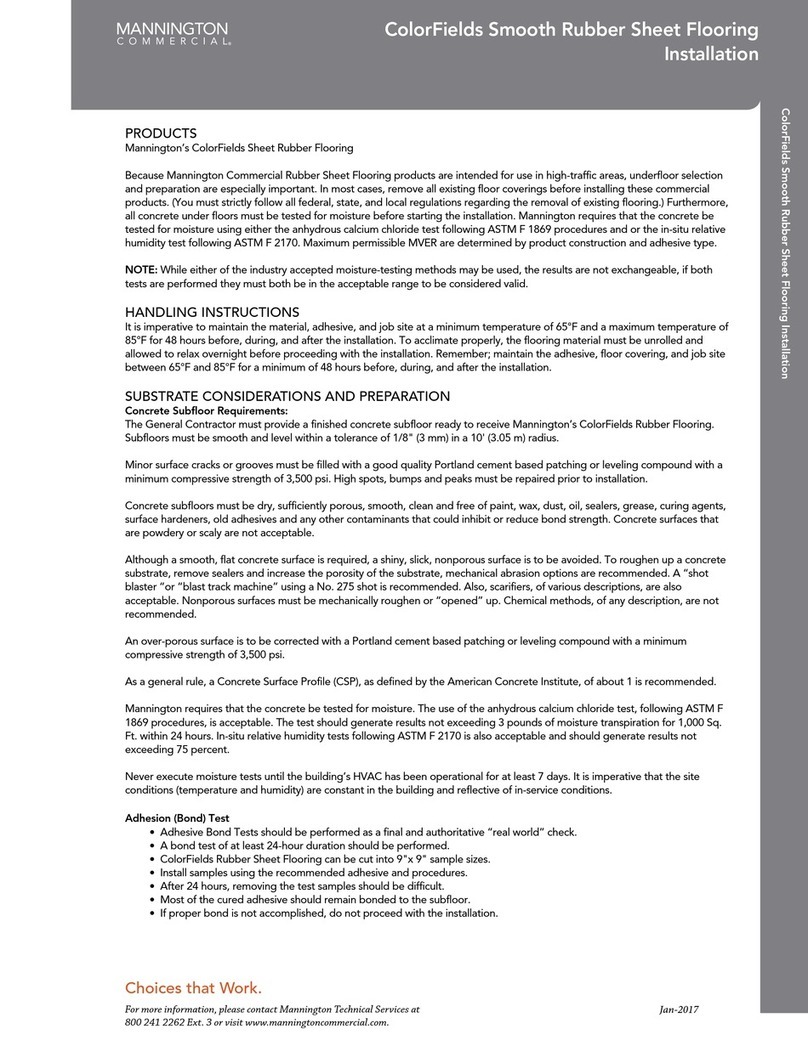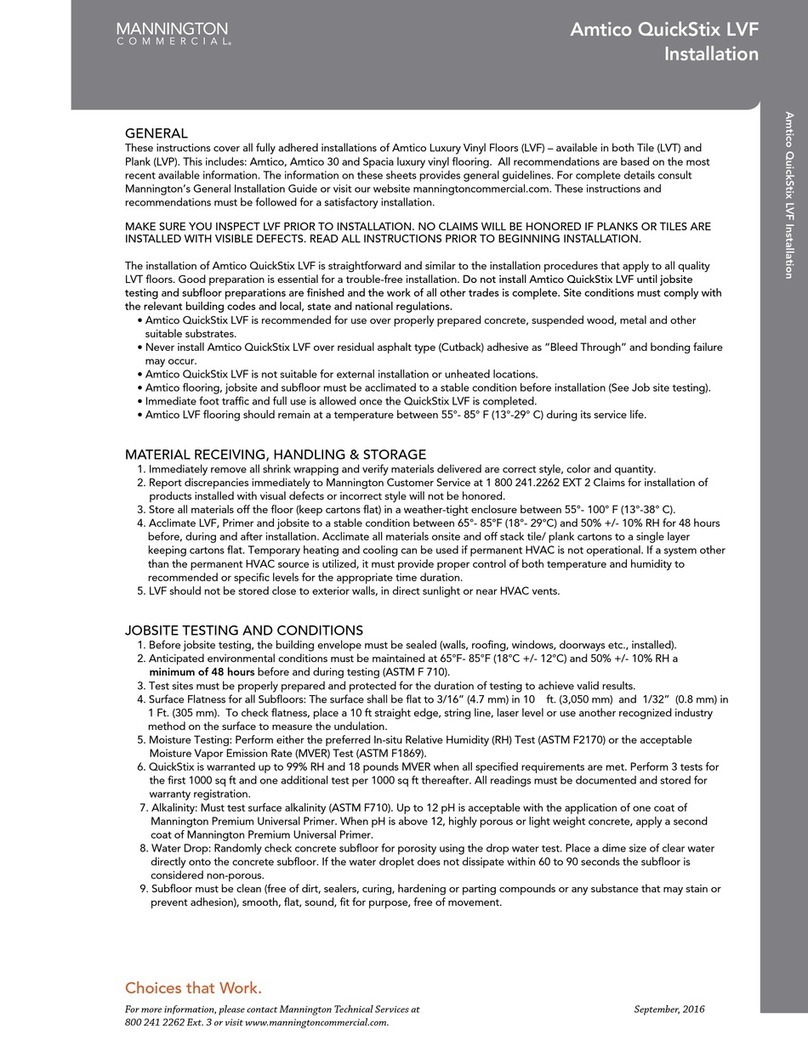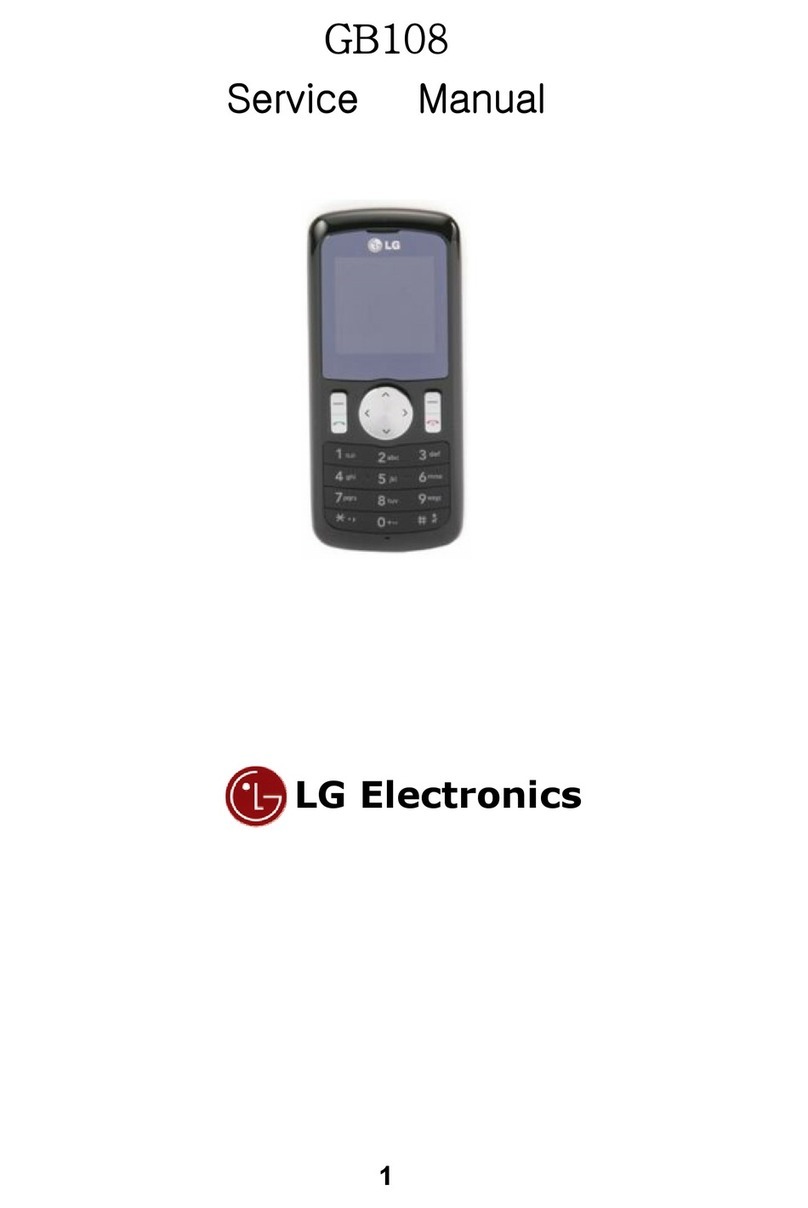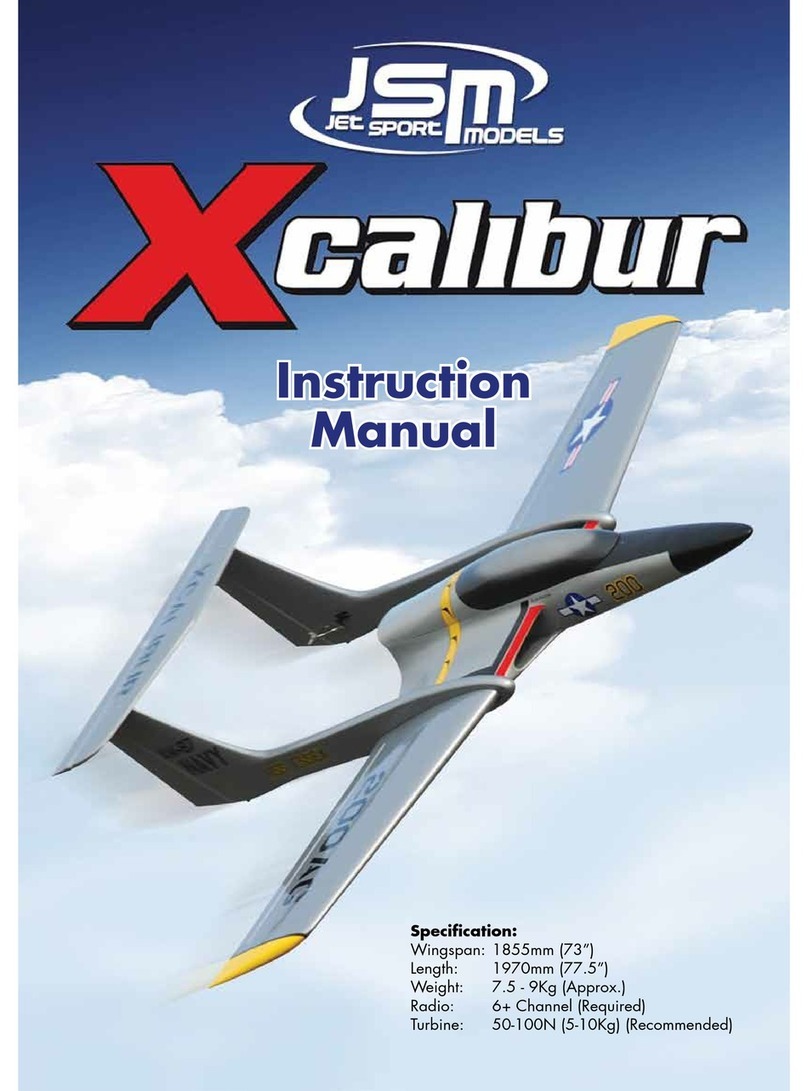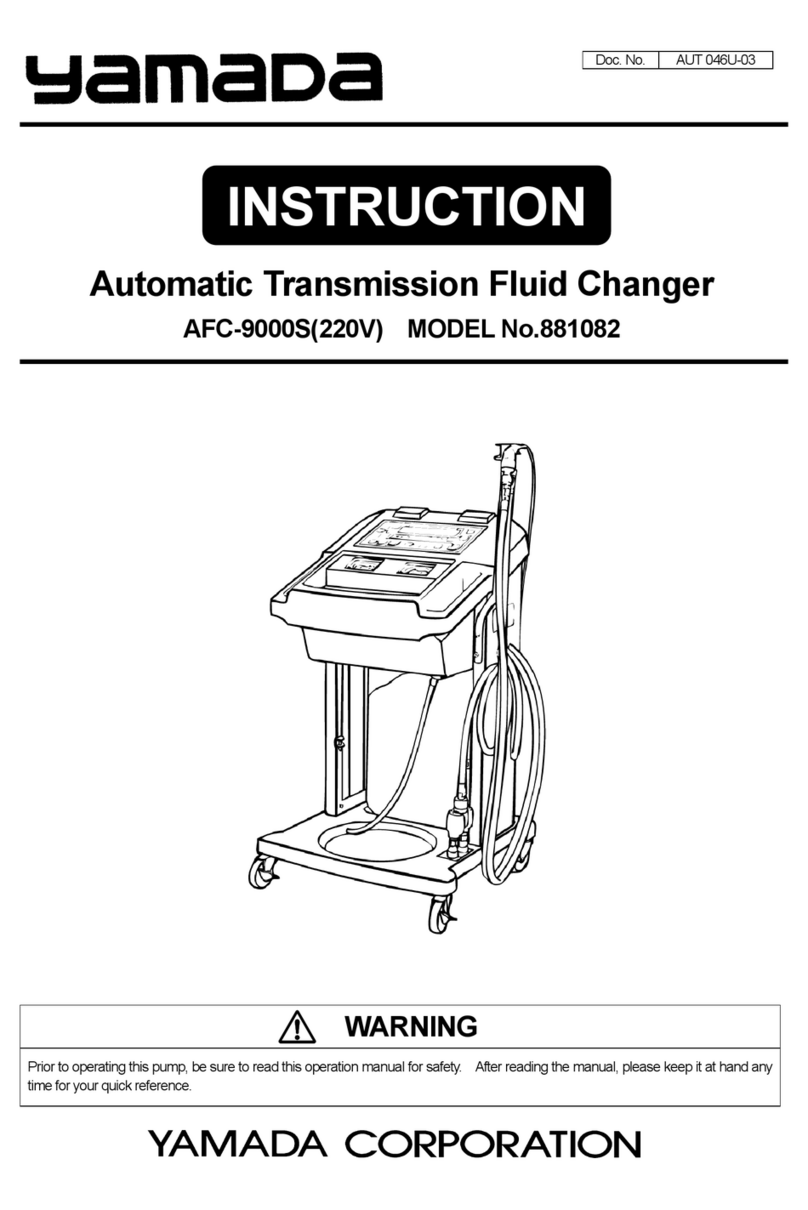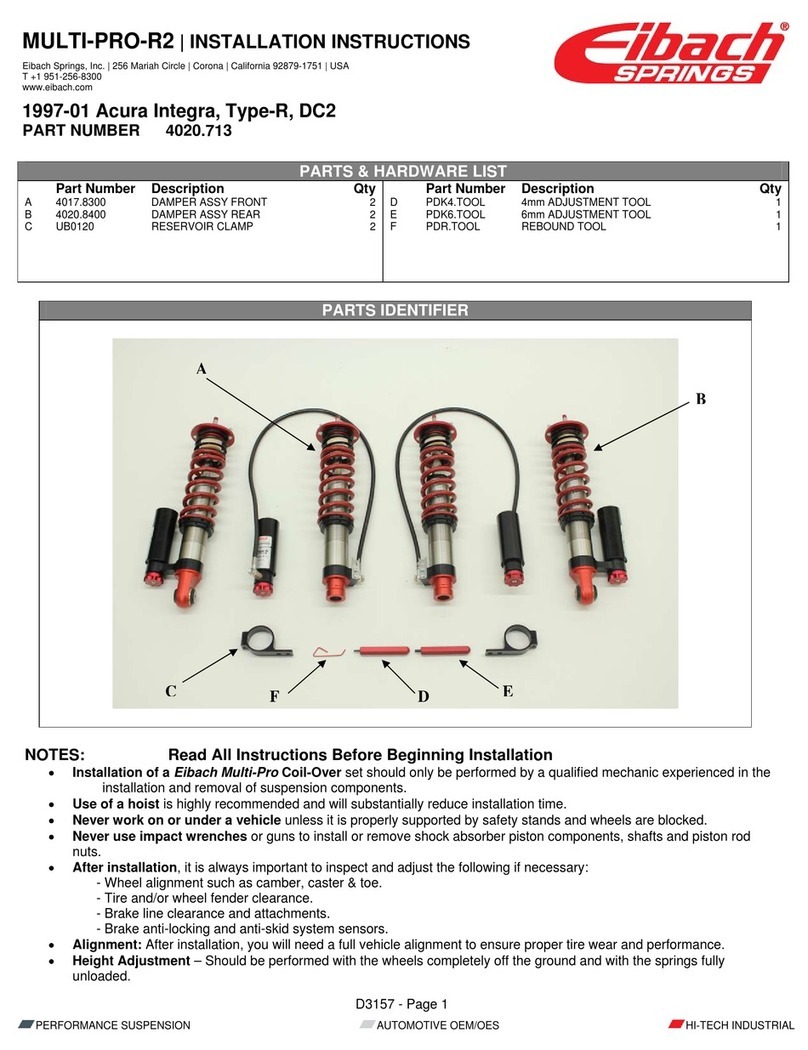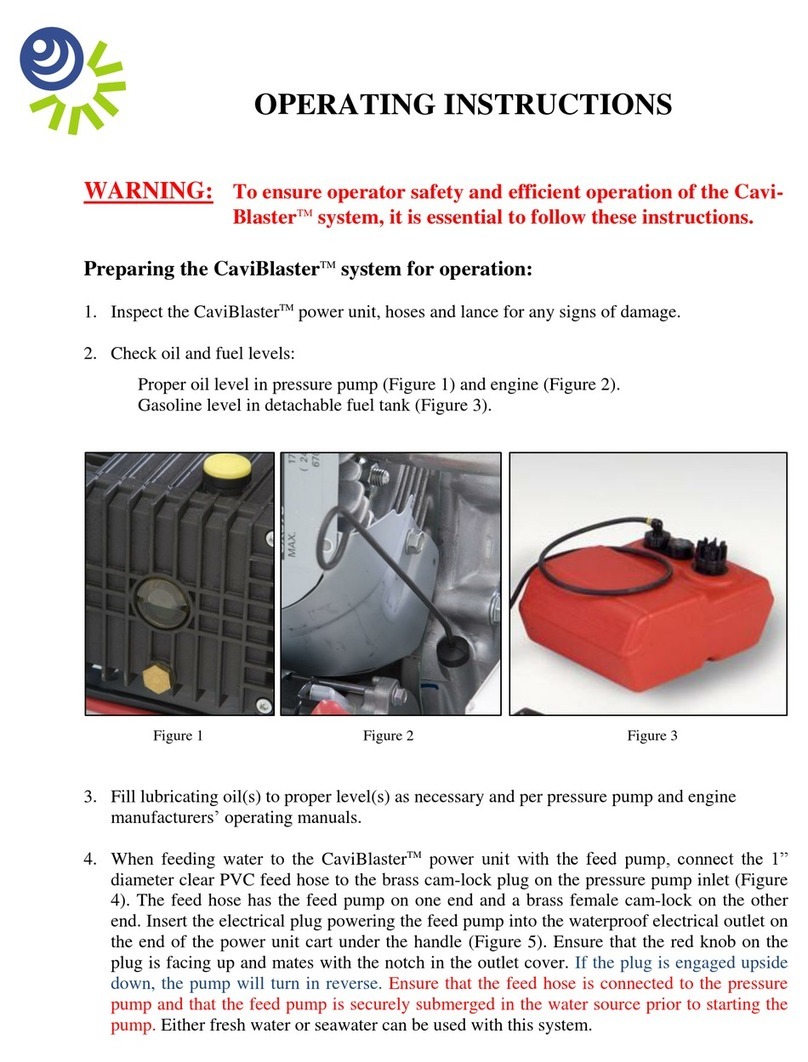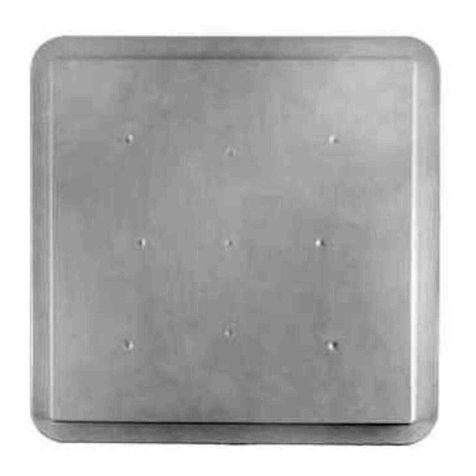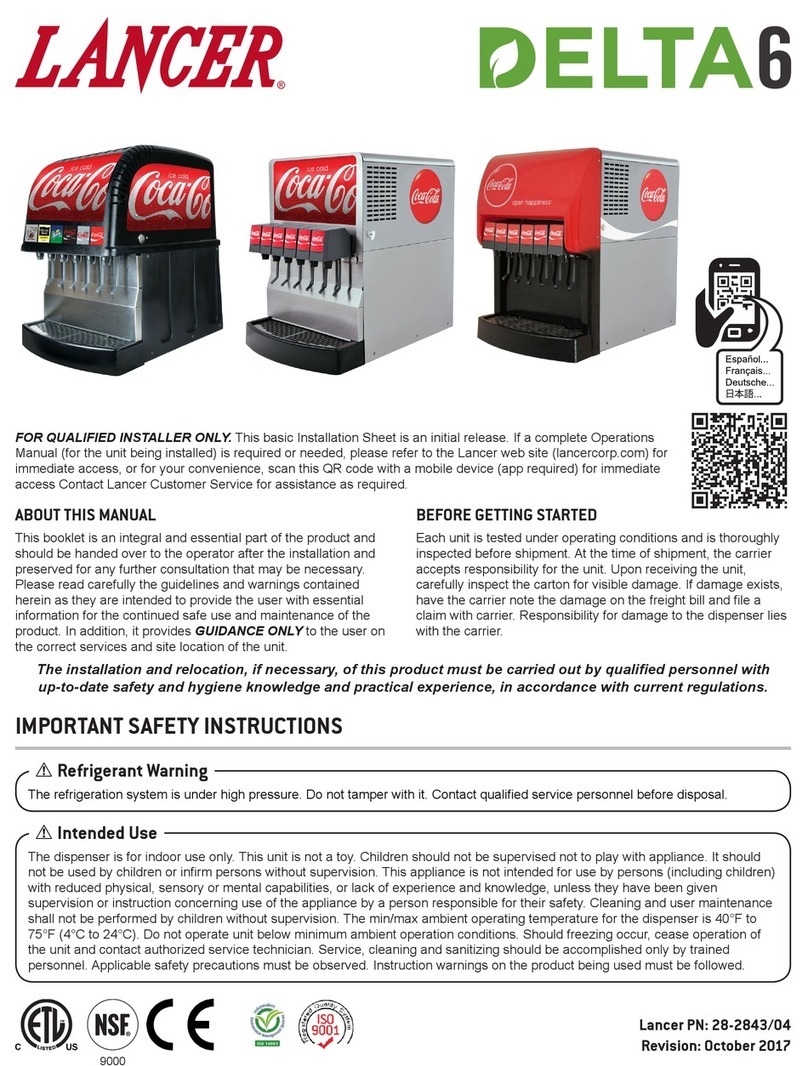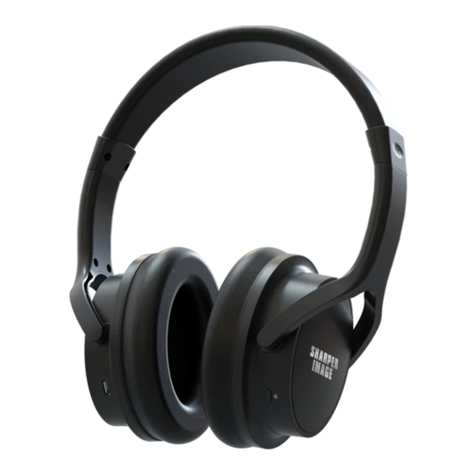Mannington commercial Integra HP RE User manual

GENERAL INFORMATION
Integra HP
®
and Integra HP
®
RE are Mannington Commercial’s high performance integrated backing systems for broadloom
carpet. Mannington adheres to the Carpet and Rug Institute’s (CRI) Installation Standard which details minimum
requirements for site conditions, floor preparation and installation. Mannington’s Installation Guide provides additional
details specifically for carpet styles with Integra HP backings. These details are necessary to help assure a successful
installation with full warranty coverage.
MANNINGTON OFFERS TWO OPTIONS FOR IN-SLAB MOISTURE CONCERNS
OPTION 1:
Requiresfull range of ASTM moistureand pH testing, but does not require the use of Mannington’sUniversalPrimer.
OPTION 2:
Requires the use of Mannington’s Universal Primer, but eliminates the need for concrete moisture testing when
subfloor chemical pH is 9 or lower.
Before starting the installation you must first determine which option is best for your specific project. Select Option 1 or 2
and then proceed to site condition.
SUBFLOOR TESTING FOR OPTION 1
Concrete subfloors must be tested in accordance with ASTM protocol to determine whether chemical pH and moisture
emission levels are suitable. Test methods, locations and results must be fully documented for future reference.
Independent certification is recommended. Results should be as follows for full warranty coverage.
•
pH test, ASTM F-710, should be 9 or less.
•
Relative Humidity, ASTM F-2170 is the preferred method and should be 85 percent or less.
•
Calcium Chloride, ASTM F-1869, should be 8 pounds or less.
SUBFLOOR TESTING FOR OPTION 2
Integra HP backing installations using Mannington’s Universal Primer, Integra 2 wet set adhesive and MT-800 seam sealer
will no longer require moisture vapor emission rate (MVER) or Relative Humidity (RH) testing, but only when meeting the
following conditions.
•
No free liquidspresent.
•
No evidence of moisture staining.
•
pH is 9 or less. pH tests are required for all installations of Integra HP backings.
Note: Testing must show the concrete surface has a chemical pH of 9.0 or lower at the time of installation and must
maintain a pH of 9.0 or lower throughout the life of the carpet. Experience has shown that test accuracy is improved for
moisture vapor emission, Relative Humidity and chemical pH when temperature and humidity levels are maintained within
ranges expected during occupancy for two full weeks prior to testing. Even so, these tests indicate moisture and pH
levels only at time of testing. Moisture and pH levels can increase over time. Mannington is not responsible for product or
installation failures caused by such changes in subfloor conditions occurring after installation.
SITE CONDITIONS: Regardless of option chosen for moisture warranty, these conditions and standards must also be met.
•
Integra HP should not be used on concrete slabs that do not have a vapor retardant membrane properly placed below
the concrete slab.
•
Control the environment. The building should be fully enclosed with an HVAC system functioning to maintain temperature
within a range similar to when space is occupied.
•
Maintain temperature between 60-85 degrees Fahrenheit with ambient humidity between 40-60 percent for 48-72 hours
before, during and after installation.
•
Levelness of finish. Must meet or exceed American Concrete Institute standards, ACI 301.
•
Use only leveling compounds containing Portland based cement. Latex is included in some levelers and should be mixed
with water according to manufacturer’s instructions. Avoid all Gypsum based patching compounds.
•
Curing agents. Mechanically remove any concrete curing agent determined incompatible with adhesives or sealers
required for installing HP backed carpets. Many concrete curing compounds can inhibit or prevent an adhesive from
developing an adequate bond with the subfloor. If concrete curing agents have been used, determine whether that
specific curing agent is compatible with sealers and adhesives necessary for the installation. Determining compatibility
may require involving manufacturers of each product.
•
Chemical removers. Avoid using chemical agents to remove curing compounds or old adhesives. That includes citrus
based removers. These solvents can absorb into the subfloor and prevent an adequate bond with sealer or adhesives.
TESTING FOR SUBFLOOR pH: All concrete subfloors must be tested for pH and found to have a pH range of 9 or less
before starting the installation. The test must be performed on bare concrete surface according to standards set in ASTM
F-710 with careful attention to the following:
•
Clean test site. Mechanically clean away adhesives, primers, curing compounds and contaminants to expose the thin
carbonation layer on the concrete surface.
January, 2018

•
Caution: Over cleaning or scraping can remove or damage the thin carbonation layer and cause higher pH readings.
•
Slightly wet the prepared site with a small amount of distilled water and allow the water to stand for one minute.
•
Apply pH test strips or pH meter to the wet concrete surface and leave intact for one full minute so the test paper can
absorb some of the distilled water.
•
The pH test strip will change colors depending upon the pH of the concrete.
LOWERING pH LEVELS: Mannington Commercial Premium Universal Primer is required for all Option 2 installations of HP
backings but can be applied to lower chemical pH levels to 9 or below as required. Primer should be applied and pH
retested as follows:
•
Universal Primer can be applied by pouring directly on the subfloor and spreading evenly with a broom or paint roller.
Primer can also be applied with a garden sprayer, an airless rig or similar spray equipment.
•
pH can be retested after subfloor has fully dried (no transfer when touched). If pH is still testing above 9, a second
applicationwillbenecessary.
•
All patched areas must receive a full application of Universal Primer.
•
Coverage is approximately 350-400 square feet per gallon.
Note: Primer required. Mannington Commercial Premium Universal Primer is required for all Option 2 installations of HP
backings on concrete when pH levels are ≤ 9 and no moisture tests are performed. Regardless of installation Option all
patched areas must receive a full application of Mannington’s Universal Floor Primer as well as any subfloor that is
porous, gritty, chalky or dusty. Excessively porous subfloors or those with chemical pH above 9 may require a second
application. Allow the primer to dry completely prior to second application or before applying adhesive. Primer is dry if
there is no transfer when touched.
ADDITIONAL SUBFLOOR TYPES: Any subfloor surface must be smooth, level, clean, and secure prior to installing carpets
with Integra HP backing.
•
Wooden planks. Wooden plank flooring will not provide a stable subfloor and must be covered with a suitable
underlayment such as plywood.
•
Plywood. Make certain plywood is recommended for use as a subfloor underlayment. Plywood seams may also need to be
sanded flat and smooth. Bare wood or plywood subfloors should be sealed with a latex primer.
•
Treated plywood. Chemicals designed to suppress fire or described as a fire retardant in wooden or plywood
underlayment will react with adhesives. Flame suppressing or fire retardant plywood is not recommended as a
suitable underlayment.
•
Terrazzo/marble. Level all grout lines. Glossy finishes may need to be sanded to provide a suitable surface.
•
Vinyl composition tile. Individual tiles must be solidly bonded to the subfloor or removed. Broken, damaged, or loose tiles
must be replaced. Remove any wax.
•
Sheet vinyl. Sheet vinyl is an unsuitable substrate and must be removed before installation.
•
Existing carpet. Existing carpet is an unsuitable substrate and must be removed.
OLD ADHESIVES:
As a general rule for any new installation, existing adhesives from previous installations should always be
scraped flat and thoroughly encapsulated with an approved sealant prior to introducing new adhesives. Otherwise, an
adverse reaction could occur, voiding applicable warranty coverage and leading to installation or product failure.
•
Multipurpose/pressure sensitive adhesives. Use one of the following methods to prevent possible reaction between the
existing adhesive and the new installation.
1.
Scrape adhesive flat and encapsulate with XL Brands TriSeal (800-367-4583) or equivalent.
2.
Thoroughly remove existing adhesive then skim coat with a Portland cement based patching compound.
•
Cutback adhesive. Wet with a mixture of water and a small amount of liquid soap. Allow to soak for several minutes
before scraping away adhesive. Encapsulate any remaining trace of adhesive residue with TriSeal (800-367-4583) or a
Portland based patching compound. Existing cutback adhesive must be thoroughly removed and encapsulated to avoid
possible installation failure.
ESSENTIAL STEPS: Integra HP backings provide exceptional performance, but like all high performance backings HP
requires special attention to specifics included here. These preliminary steps are essential for a successful installation.
•
Check style and color. Before cutting or installing carpet the installer is responsible for making sure all styles and colors
match samples selected for the project. Mannington cannot be responsible for installation with visible defects, incorrect
colorsorstyles.
•
Dye lots. Mannington does not recommend mixing dye lots, especially in open areas that would be highly visible. Mix dye
lots only if necessary in natural break areas where dye lot change would be less noticeable. Always get prior approval
before mixing any dye lots.
•
Dry lay/acclimate. All Integra HP carpet must be allowed to acclimate prior to installation. All carpet should be rolled out
and allowed to acclimate for a full 24 hours.
•
Random, non patterned styles. For random or non patterned styles rolls should be sequenced according to roll numbers.
January, 2018

•
Patterned styles. Stage each roll by pattern length instead of roll number as outlined below.
•
Implement roll sequence when possible after pattern length.
PATTERN STYLES WITH INTEGRA HP BACKING
•
Patterned styles must be staged by pattern length rather than roll number sequencing. Patterns often vary especially in
longer drops. Measure pattern lengths on each roll and sequence rolls as detailed here.
•
Pattern sequence. Rolls with longest patterns must be installed first followed by rolls with gradually decreasing pattern
length. Rolls with shorter patterns must be power stretched into alignment with longer patterns. Even when pattern
sequence is provided, always double check on site and sequence rolls as follows:
1.
Count full patterns. Count only full patterns within an approximate 10 foot length on each roll. Five foot lengths can be
used for very smaller patterns. Multiple patterns must be measured in a group to get the most accurate sequence
possible. The multiples used here can make this important process more simple, consistent and accurate.
2.
Measure lengths. Carefully measure length on a group of patterns, starting at the upper tip of first pattern to lower tip
of the last pattern. Pattern grouping will likely be slightly longer or shorter than exactly 120 inches (10 feet). Fractions
of an inch matter.
3. Check and record pattern sizes in at least two locations on each roll.
4. Create sequence list. Note roll number, pattern count, and length measurement.
5. Longest patterns first. Stage each roll so the roll/rolls with longest patterns are installed first. Install each roll so pattern
groups get progressively shorter.
Pattern length always varies within a run. Six patterns on Roll 1 total
119¾-inches tip-to-tip, while six full star patterns total 120-inches on Roll 3.
On Roll 2, six patterns are 1201/3 -inches long. These rolls must be sequenced,
alligned, and installed by pattern length as follows:
v Roll 2 has the longest six patterns and must be installed first.
v Roll 3 has slightly smaller patterns and should be instslled second.
v Roll 1 has the shortest grouping of six patterns and must be installd last.
Power-stretch shorter patterns into allignment with longer patterns. Maintain
stretch, stay nail to hold patterns in allignment and leave nails in place until
adhesive has firmly set.
MAKING CUTS: Integra HP broadloom requires a specific tool and technique for creating
seams that are consistently tight and secure. Follow these specific instructions when cutting
seams.
•
Seam cutter. Only use the 575 Commercial Seam Cutter by National Carpet Equipment
(800-245-0267) to prevent fullness. Fullness will cause seam to peak before the wet set
adhesive can develop grab.
•
Side seams. The 575 cutter is designed to row cut top width while simultaneously trace
cutting a second width positioned underneath. This double cutting method combines row
cutting and trace cutting for a net cut without fullness.
•
Dry cut all seams. Avoid making double or trace cuts after adhesive has been spread. Making cuts in wet adhesive (wet
cutting) removes adhesive underneath seam; wet glue transfers to the portion of carpet backing being trimmed away. This
installation technique will cause seam failure and should never be used. Spread adhesive along the seam area only after
cut is made and while subfloor is still adhesive free or dry.
•
Side seam cuts. Making side cuts requires significantly different techniques depending on whether the carpet style
involves a random or distinct pattern.
1.
Random or non-patternedstyles should be double cut along a straight line.
2.
Patterned styles should be cut oneach width separately byfollowing a straightedge from patternto pattern.
ADHESIVE:
Integra 2 is a wet-set adhesive required and specifically tailored for both Integra HP and Integra HP RE
backings. The wet-set properties of Integra 2 differ from other types of adhesives that need some drying or open time
before installing flooring material. Integra 2 permits immediate installation of Integra HP and provides essential wet
adhesive transfer from subfloor to Integra HP vinyl backings. Both Integra backings require this transfer of wet adhesive
before a secure bond can develop. Integra 2 adhesive is for use with HP backings only and no other flooring.
Note these
im ortant recautions rior to installation.
•
Wet only: Once spread onto the subfloor Integra 2 should never be allowed to skim over or begin drying from the surface
before installing carpet with HP backing.
•
Cure times: HP backings are designed to prevent moisture penetration. That means wet adhesive may need several days
January, 2018

for moisture to escape sufficiently for the adhesive to develop a full bond that comes only with drying and curing.
Subfloor porosity, temperature and humidity levels can have a major impact on adhesive set up or cure times.
•
Delayed grab: The wet set properties of Integra 2 will delay grab or tack until the adhesive can begin to cure. When
patterned carpet styles are stretched into alignment, use stay nails to hold carpet in place until adhesive is fully set. Please
note that Integra 2 wet set adhesive may require three or more days to develop a solid bond.
•
Spread rate: Once seam edges are trimmed, carefully fold back seams on half of carpet width to expose subfloor. Apply
Integra 2 adhesive with a 1/16x1/16x1/16 inch square notch trowel. The square notches are 1/16 wide, 1/16 deep, and
1/16 apart.
•
Coverage: Spread rate should cover about 15 square yards per gallon on smooth subfloor surfaces. Coverage will be less
over rough or more porous subfloors and more adhesive will be required.
•
Roller: Each carpet width installed must be thoroughly rolled with a 35-75 pound 3 section roller immediately after being
placedintoadhesivetoremoveairpocketsandensureadhesivetransfer.Pushrollerawayfromseamto
avoid breaking sealer bond.
IMPORTANT NOTE:
Mannington adhesives are specifically formulated to be fully compatible with
backings, chemistry and to maximize the performance of Mannington products. Using substitutes
or failing to use Mannington adhesives as recommended can cut short product life, cause
installation failure and /or lead to a chemical reaction such as hydrolysis which can permanently
damagethebackingand
will void all applicable warranty coverage.
SEAM SEALER: All seams must be chemically welded with Mannington MT-800 seam sealer to
assure performance and maintain full warranty coverage. MT-800 should be used as follows:
•
Correct flow. Fill applicator bottle with MT-800. Adjust flow control nozzle to deliver consistent 1/8 inch bead (backing
thickness).
•
Placement. Apply a consistent 1/8 inch bead of MT-800 along HP backing edge first once carpet width is placed into
adhesive. Take care to avoid getting seam sealer onto carpet face fiber.
•
Making seams. Place second carpet width into adhesive so two carpet widths come together with slight compression to
form a tight seam.
•
Sealer precaution. The entire seaming process must be completed within 10 minutes to avoid having MT-800 seam sealer
harden toosoon.
•
Remove excess. Quickly clean away any excess MT-800 pushed up into the face fiber. MT-900 seam cleaner should be
used to remove excess MT-800 while the sealer remains wet.
•
Technique. Dampen a clean white absorbent cotton cloth with MT-900 and gently rub the seam where sealer has
surfaced. Do not pour seam cleaner directly on the carpet. Use this final step as final check to make sure seam is tight and
properly sealed.
•
Coverage. Expect a 1/8 inch bead to yield approximately 500 linear feet of seams per pint.
STAIRWAYS: Integra HP backings will resist conforming to a tight bend necessary for some applications, but can be
successfully installed on many stairways with the following techniques:
•
Separate cuts. Carpet with either HP backing can be cut to fit each step and riser. Apply adhesive to carpet
backing andstep/riser.
•
Stair nosing. Use an appropriate stair nosing to cap carpet edges.
TRANSITIONS
•
All carpet products must be properly protected when transitioning to other floor covering or exposed stopping
points. The use of a transition molding or protective strip covering the carpet edge at ½” is required. If a transition
cannot be utilized the carpet nap must be level or slightly below the adjacent floor. The carpet edge must be fully
seam sealed to protect from raveling or damage.
PROTECT INSTALLATION
•
Use Masonite or plywood during furniture move-in. If additional protection is required to prevent damage by other
finish trades use bonded craft paper, which will allow adhesives to cure without risk to the new installation. Avoid
using plastic sheeting to protect any installation. Coverings with pre-applied adhesive can leave sticky residue,
cause rapid soling, and should not be used to protect the installation.
January,2018

TIPS: The following tips are offered to help assure a successful installation:
•
Extra manpower: Additional manpower may be necessary to prevent shifting when long drops are folded back and forth
for spreading adhesive ormakingseams.
•
Along walls: Fat or excessively full cuts should be avoided to prevent bubbles on Integra HP backings. Trim along walls
using a wall trimmer to yield a net cut or slightly less than net.
•
Cross seams: Minimize seam peaking by reverse rolling or back rolling cross seam edges before placing carpet
into adhesive.
•
After install: Avoid rolling traffic including furniture move in for full 72 hours. Use plywood runners to protect carpet when
moving heavy furniture. Limit foot traffic for 24 hours.
•
Chair pads: Chair pads are recommended, but not required, to prevent distortion of the carpet’s face fiber underneath
rolling office chairs.
WARRANTY NOTE: Installation of Mannington Integra HP products that exceed the specifications and limitations
provided will void the warranty. All Option 2 projects must be registered under Mannington’s Integra HP job
registration form.
QUESTIONS? If there are any questions or doubts about performing a successful installation of Mannington’s Integra HP
or Integra HP RE broadloom carpet, please stop immediately and call Technical Services at 800-241-2262, Ext. 3.
January,2018
This manual suits for next models
1
Table of contents
Other Mannington commercial Other manuals
Popular Other manuals by other brands
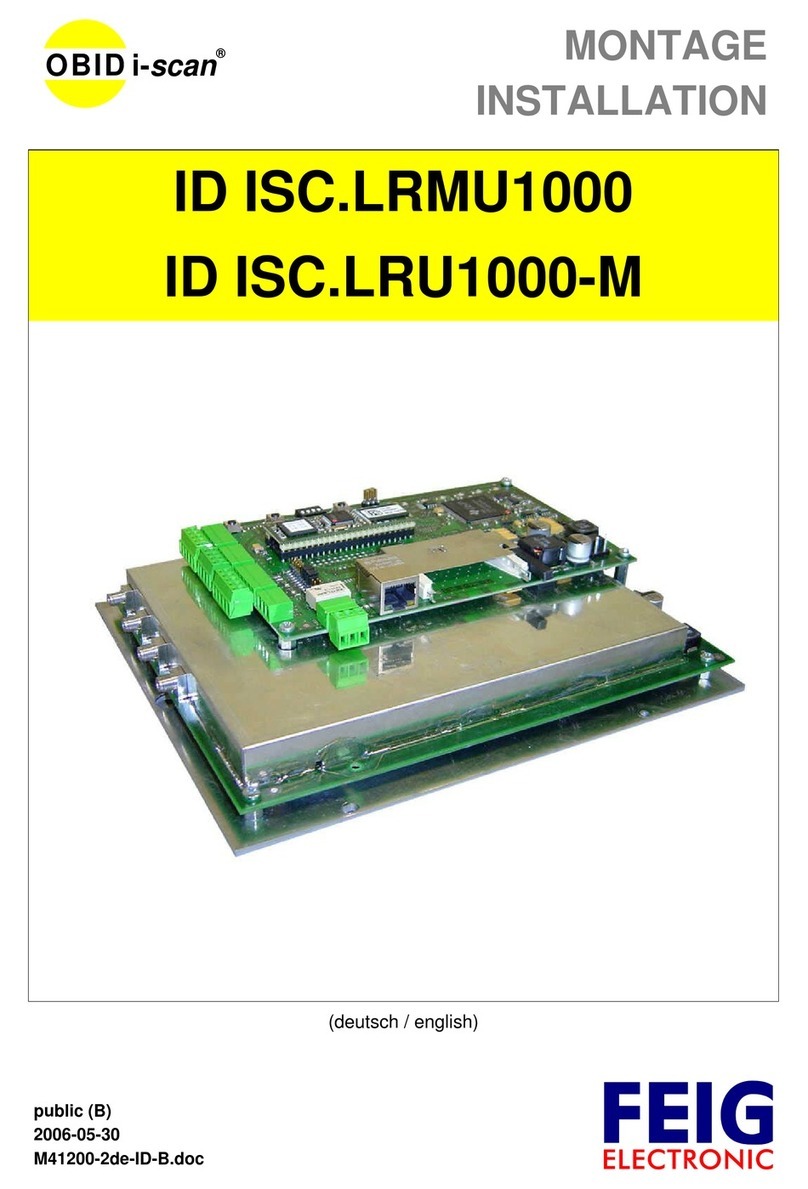
Feig Electronic
Feig Electronic OBID i-scan ID ISC.LRMU1000 installation manual
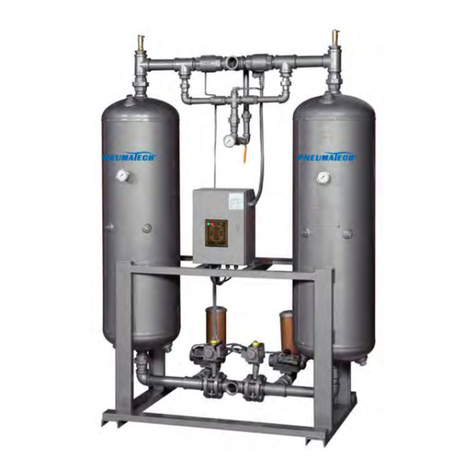
Pneumatech
Pneumatech PHM Series owner's manual

Tetrafauna
Tetrafauna Viquarium quick start guide
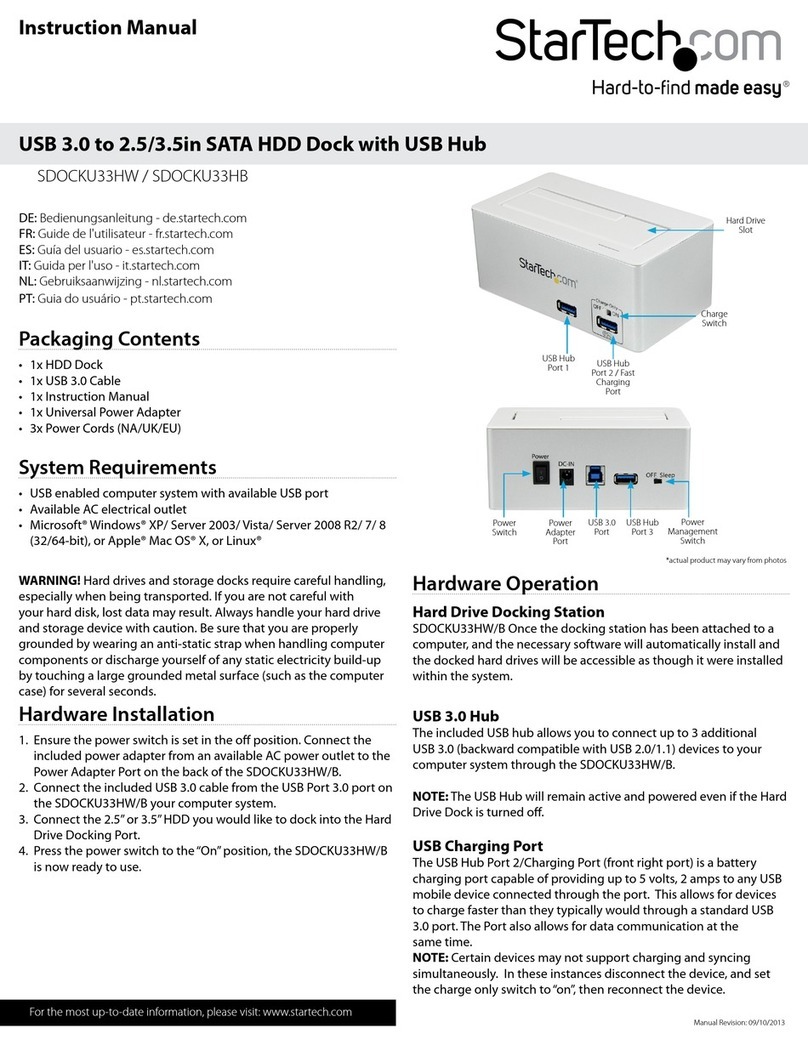
StarTech.com
StarTech.com SDOCKU33HB instruction manual

Blue Ox
Blue Ox BX1625 installation instructions
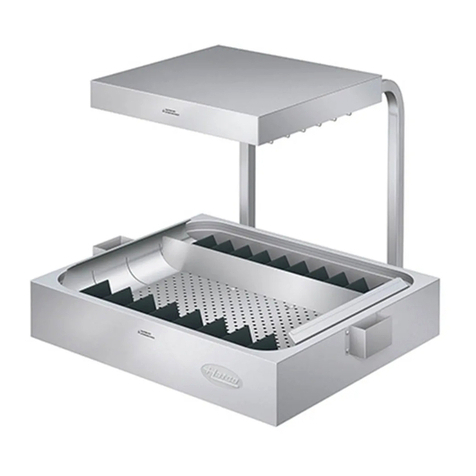
Hatco
Hatco Glo-Ray GRFHS-PT26 brochure
